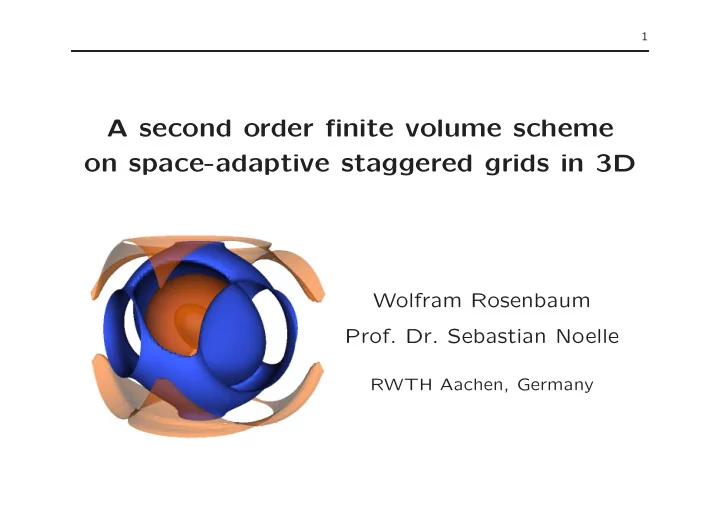

1 A second order finite volume scheme on space-adaptive staggered grids in 3D Wolfram Rosenbaum Prof. Dr. Sebastian Noelle RWTH Aachen, Germany
Staggered grid construction in 1D 2 How to construct dual cells dual cell dual grid primal grid primal cell • split volume of a primal cell • assign volume parts to the nodes of the primal cell • assemble dual cells around each primal node ⇒ split primal cell into halves = only one splitting rule in 1D
Staggered grid construction in 2D 3 Splitting a primal cell 1. primal cell 16 squares → 2. inner squares 2 triangles → 3. assign atoms nodes on primal cell �→
Staggered grid construction in 2D 4 Assembling local patterns six local patterns dual grid • connecting patterns yields to planar dual faces
Staggered grid construction in 3D 5 Primal grid properties • structured adaptive octtree • 1-level transition over common faces and edges
Staggered grid construction in 3D 6 Splitting a primal cell 1. primal cell 64 cubes → 2. face-inner cubes 2 prisms → 3. interior cubes 6 tetrahedra → 4. assign atoms nodes on �→ primal cell
Staggered grid construction in 3D 7 227 combinatorially different local patterns . . . and many others
Staggered grid construction in 3D 8 Assembling local patterns • connecting patterns yields to planar dual faces • dual faces composed of simple geometric shapes (triangles, rectangles)
Numerical example: First Order Rotating Cone 9 initial data at t = 0 exact solution at t = π/ 2
Numerical example: First Order Rotating Cone 10 t = 0 t = π/ 6
Numerical example: First Order Rotating Cone 11 t = π/ 3 t = π/ 2
Towards a second order scheme 12 Algorithmical demands • pw. linear reconstruction of cell centered conservative data → solve local data-dependent least-square problem with built-in slope limitation [ Ollivier-Gooch, 1996 ] • execute second order integration in space (over volumes and faces) and time → midpoint rule for time integration and space integration over volumes → trapezoidal rule for space integration over faces
Towards a second order scheme 13 Flux integration • composed n-sided dual faces v 4 v 5 • # dual face parts ≫ 3 # dual nodes v 3 p 3 • cog often on primal boundary p p 1 p 2 • evaluate fluxes in dual nodes v 1 v 2 • weights for 2 nd order quadrature
Towards a second order scheme 14 Barycentric weight splitting w 5 w 4 w 0 = R 1 4 R 3 T 1 w 1 = R 1 + R 2 w 6 w 3 4 composed dual face w 7 w 7 = R 1 + R 2 + R 3 + T 1 4 3 R 1 R 2 w 0 w 1 w 2 w 5 w 5 w 4 w 4 w 5 w 4 R 3 T 1 w 6 w 3 w 6 w 3 w 6 w 7 R 1 R 2 w 0 w 1 w 2 w 0 w 1 w 2 w 0 w 2
Numerical example: Second Order Rotating Cone 15 t = 0 t = π/ 6
Numerical example: Second Order Rotating Cone 16 t = π/ 3 t = π/ 2
Comparison of First and Second Order Rotating Cone 17 first order second order
Constructive Solid Geometry 18 AND = OR =
Constructing a Nozzle 19 → modify FV scheme in cut cells without CFL-number limitation [ Pember, Bell, Colella, Crutchfield, Welcome, 1995 ]
Conclusion 20 • 3D Riemann solver free second order Finite Volume scheme • higher local effort, lower global cost • CSG-styled adaptive cartesian grids • pattern-based construction of dual mesh • patterns generated on demand and stored in look-up tables
Outlook 21 in progress: • adapt numerical scheme for cut cell handling • incorporate various boundary conditions (inflow, outflow, . . . ) in order to: • run complex applications • compare the scheme to competing methods
Recommend
More recommend